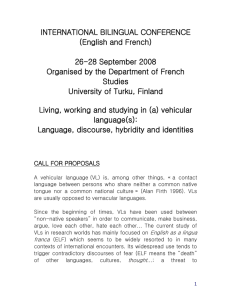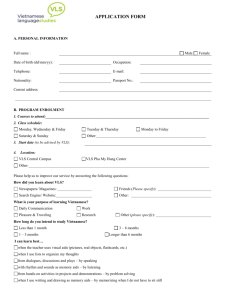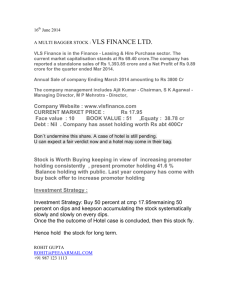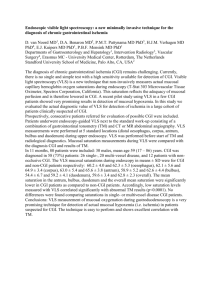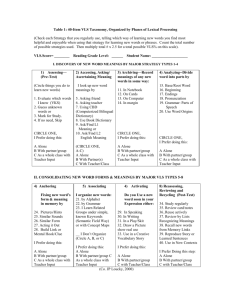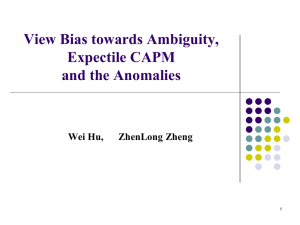Learning Strategies for Vocabulary Development
advertisement
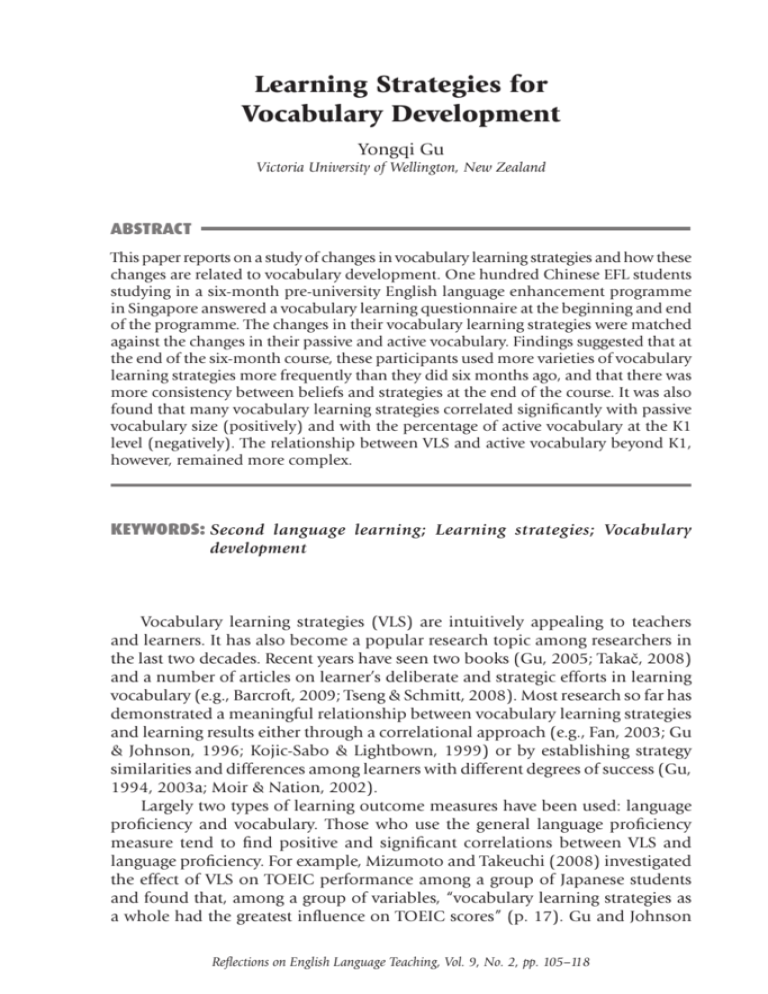
Learning Strategies for Vocabulary Development 105 Learning Strategies for Vocabulary Development Yongqi Gu Victoria University of Wellington, New Zealand ABSTRACT This paper reports on a study of changes in vocabulary learning strategies and how these changes are related to vocabulary development. One hundred Chinese EFL students studying in a six-month pre-university English language enhancement programme in Singapore answered a vocabulary learning questionnaire at the beginning and end of the programme. The changes in their vocabulary learning strategies were matched against the changes in their passive and active vocabulary. Findings suggested that at the end of the six-month course, these participants used more varieties of vocabulary learning strategies more frequently than they did six months ago, and that there was more consistency between beliefs and strategies at the end of the course. It was also found that many vocabulary learning strategies correlated significantly with passive vocabulary size (positively) and with the percentage of active vocabulary at the K1 level (negatively). The relationship between VLS and active vocabulary beyond K1, however, remained more complex. KEYWORDS: Second language learning; Learning strategies; Vocabulary development Vocabulary learning strategies (VLS) are intuitively appealing to teachers and learners. It has also become a popular research topic among researchers in the last two decades. Recent years have seen two books (Gu, 2005; Takač, 2008) and a number of articles on learner’s deliberate and strategic efforts in learning vocabulary (e.g., Barcroft, 2009; Tseng & Schmitt, 2008). Most research so far has demonstrated a meaningful relationship between vocabulary learning strategies and learning results either through a correlational approach (e.g., Fan, 2003; Gu & Johnson, 1996; Kojic-Sabo & Lightbown, 1999) or by establishing strategy similarities and differences among learners with different degrees of success (Gu, 1994, 2003a; Moir & Nation, 2002). Largely two types of learning outcome measures have been used: language proficiency and vocabulary. Those who use the general language proficiency measure tend to find positive and significant correlations between VLS and language proficiency. For example, Mizumoto and Takeuchi (2008) investigated the effect of VLS on TOEIC performance among a group of Japanese students and found that, among a group of variables, “vocabulary learning strategies as a whole had the greatest influence on TOEIC scores” (p. 17). Gu and Johnson Reflections on English Language Teaching, Vol. 9, No. 2, pp. 105–118 106 Yongqi Gu (1996) used both a general proficiency measure and a vocabulary size measure. However, despite a generally positive correlation between VLS and English proficiency and vocabulary size, Gu and Johnson reported that some strategies aimed at vocabulary retention correlated significantly with vocabulary size but not with general proficiency. This suggests a dynamic and prolonged nature of vocabulary development from initial linking and storage of form-meaning pairs (reflected to a certain extent in passive vocabulary size) to a gradual shift of these words to the active stock and finally to an integration of words into the general linguistic competence. A wide array of VLS should, therefore, be used at different stages of learning to commit words to memory and to automate the use of these words in real language use contexts. The overwhelming majority of vocabulary measures in VLS studies have been some type of passive vocabulary size measure, in other words, the number of words a learner can recognize. A number of active vocabulary measures have been proposed (Laufer, 1998; Laufer & Nation, 1999; Meara & Bell, 2001; Meara & Fitzpatrick, 2000). However, none of these has been able to satisfactorily measure active vocabulary size. One of the most widely used measures of active vocabulary so far is arguably Laufer and Nation’s (1995) Lexical Frequency Profile (LFP), which sketches the profile of a learner’s active vocabulary use by providing the percentage of words used that belong to the first 1,000 most frequently used words, the percentage of the second 1,000 words, that of the Academic Word List, and that of words that do not fall into the lists compared (Morris & Cobb, 2004; Muncie, 2002). Probably due to this lack of a single satisfactory measure of active vocabulary (Meara & Olmos Alcoy, 2010; Read, 2000), practically no VLS study has looked at how strategies are related to the growth of active vocabulary. Besides the lack of knowledge on productive vocabulary learning strategies, very little is known about the change of VLS over time; nor do we know much about the effect of this change on the development of vocabulary along both passive and active dimensions. The only study I am aware of is Cortazzi and Jin’s (1996) cross-sectional description of VLS changes of 212 university students in China. These students were asked to report on a questionnaire the strategies they were using, how effective they thought these strategies were, and recall on their use of the same strategies when they were in secondary schools. Cortazzi and Jin reported that major changes occurred from secondary school to university in terms of both VLS and their perceived effectiveness. Strategies used in secondary schools included mainly reading textbooks, listening to the teacher and taking notes; whereas a much larger repertoire was reported in university, including more opportunities for use such as writing essays, listening to radios, and talking to English teachers and native speakers. Some ways of learning vocabulary remained remarkably stable. These included classroom based activities such as listening to the teacher and taking notes. Outside the classroom, memorizing vocabulary remained the most widely used strategy. In addition to proficiency growth that demands different strategy use, learning strategies shift with contexts of learning (Gu, 2003b). In the current study, I am interested to find whether the dramatic change of learning context from an EFL environment in China to an ESL context in Singapore would change the VLS Learning Strategies for Vocabulary Development 107 a group of Chinese students used. I examine if the change of VLS is related to growth in passive and active vocabulary. In particular, the present study aims to answer the following two research questions: 1. Are there significant changes in vocabulary learning strategies after a sixmonth English enrichment programme in Singapore? 2. How are vocabulary learning strategies related to vocabulary development (passive vocabulary level and active vocabulary use) at the beginning and end of the programme? Method Subjects Every year, the Singapore government selects a group of students from universities in China and supports their study at a university in Singapore. These students need to complete a six-month English language enrichment programme in order to be able to cope with English-medium instruction in Singapore. The students who participated in this study were selected from 14 universities in China where they had just begun tertiary studies. They filled in a vocabulary learning strategies questionnaire immediately after a placement test at the beginning of the proficiency enrichment programme in Singapore. The same questionnaire was again administered six months later during the last week. One hundred complete sets of pre- and post-questionnaires were collected at the end of the programme. Seventy three of these were from male students; and 27, from females. The participants’ age ranged from 17 to 21, with the majority of them 19 (51%) and 18 (30%). The voluntary nature of the project meant that the data were not complete for all students. This will be reflected in the varied number of participants for various calculations. Instruments and Procedures The instrument used for the elicitation of VLS was Vocabulary Learning Questionnaire (Version 5, or VLQ5), a ninety-item update by Gu and Hu (2003) of Gu and Johnson’s (1996) VLQ. Each of the ninety statements was followed by a 7-point Likert scale. The Beliefs section ranged from 1, Absolutely disagree, to 7, Absolutely agree. The Strategies section ranged from 1, Absolutely untrue of me, to 7, Absolutely true of me. Table 1 lists the major dimensions and categories of VLS, which the VLQ covers (Version 5). The first administration of VLQ5 at the beginning of the programme required the participants to recall how they had been learning vocabulary the previous two years before they moved to Singapore. The second administration at the end of the programme required the respondents to answer according to how they were learning vocabulary during the six-month intensive English language training in Singapore. To avoid misunderstanding, the Chinese version of VLQ5 was used for both occasions. Table 2 reports the Cronbach’s alpha (α) reliability (internal consistency) for the two administrations of VLQ5. The reliability of the first 108 Yongqi Gu Table 1 VLQ5: Dimensions, Categories, and Items (Gu & Hu, 2003) Number of variables Number of items 2 12 Selective attention Self-initiation 2 10 Initial handling Guessing Dictionary use Note-taking 2 3 2 10 14 8 Reinforcement Rehearsal Encoding 3 6 11 20 1 5 21 90 Dimensions Categories Beliefs Metacognitive strategies Cognitive strategies Activation Total Table 2 VLQ5 Item Distribution and Reliability Statistics Number of items α1 α2 Words should be memorized. Words should be learned through use. 6 6 .7116 .5940 .7744 .6069 Metacognitive strategies Selective attention Self-initiation 5 5 .6829 .7062 .7631 .6515 Contextal guessing Wider context Immediate context 5 5 .7224 .6716 .7282 .7245 Dictionary strategies Dictionary strategies for comprehension Extended dictionary strategies Looking-up strategies 4 5 5 .7157 .7894 .7236 .6902 .7329 .6272 Note-taking Meaning-oriented note-taking Usage-oriented note-taking 4 4 .6488 .7151 .6527 .6335 Rehearsal strategies Use of word lists Oral repetition Visual repetition 5 3 3 .6913 .5516 .5421 .6504 .4931 .5590 Encoding strategies Association/elaboration Visual encoding Auditory encoding Use of word structure Semantic encoding Contextual encoding 4 4 3 3 3 3 .4973 .6992 .7318 .7756 .6544 .6725 .6706 .7177 .7168 .6773 .5100 .6880 Active use Activation strategies 5 .7557 .7442 Categories Strategies Beliefs about vocabulary learning Learning Strategies for Vocabulary Development 109 administration is labelled α1, and that of the second administration is labelled α2. As a quick passive vocabulary measure administered together with the questionnaires, the 3000-word level of Nation’s (2001)Vocabulary Levels Test was combined with Goulden, Nation, and Read (1990). Crude as it was, the combined measure was thought to be indicative of the participants’ learning background1 as well as their passive vocabulary level at the time. Active vocabulary was measured by the Lexical Frequency Profile (LFP). This was based on two of the participants’ in-class argumentative compositions collected from their writing class at the beginning and end of the programme. Their first composition focused on the brain-drain phenomenon in developing countries, while the last composition was about their arguments for or against cloning. Each composition was typed and an LFP was obtained by submitting it to Tom Cobb’s Vocabulary Profiler at http://www.lextutor.ca/vp/. For the purpose of this project, the LFP included the number of types, tokens, and word families contained in each composition. It also included the percentages of words that fall into the first 1000 most frequent words (K1), the second 1000 most frequent words (K2), words that belong to the Academic Word List (AWL) (Coxhead, 2000), and off-list words. Analysis Changes in passive and active vocabulary and changes in VLS over the six-month period were captured by paired t-tests comparing the respondents’ pre- and post vocabulary measures as well as their answers to the pre- and post questionnaires. To examine the effect of strategy use on vocabulary development over the sixmonth programme, Pearson correlations were obtained between VLS on the second questionnaire and the passive and active vocabulary measures. Findings Changes in Vocabulary Significant improvement in both passive and active vocabulary was found across the board (Table 3). The passive vocabulary at the end was significantly larger than that at the beginning of the programme. The one-hour in-class composition students wrote in their last week contained significantly more tokens, more types, and more word families than the composition they wrote in the first week of the programme. An average of 89% of the first composition was made up of the first 1000 most frequent words. This percentage was reduced to 83% by the end of the six- month programme. In the meantime, the average percentage of K2 1 Most Chinese students place a great emphasis on expanding their vocabulary size, often indiscriminately (Cortazzi & Jin, 1996). For example, many spend years memorising vocabulary lists or even dictionary entries from A to Z. This results in some very low frequency words being remembered. It was therefore decided to use Goulden, Nation, and Read (1990) to capture these words that another level in the VLT, e.g., 5,000-word level, would not be able to capture. 110 Yongqi Gu Table 3 Changes in Passive and Active Vocabulary M n SD t p Passive Vocabulary Vocabulary size Pre Post 12.66 20.72 85 85 4.60 5.50 -18.33 .000 Active Vocabulary Tokens Pre Post 392.86 454.02 83 83 73.66 70.57 -7.47 .000 Types Pre Post 166.95 180.61 83 83 28.35 30.16 -4.55 .000 Type/Token ratio Pre Post .43 .40 83 83 .050 .052 5.27 .000 Families Pre Post 129.14 140.28 83 83 21.46 22.57 -5.10 .000 K1 Pre Post 89.16 83.04 83 83 3.36 3.62 12.88 .000 K2 Pre Post 2.98 4.96 83 83 1.47 1.68 -8.03 .000 AWL Pre Post 1.96 4.57 83 83 1.51 1.77 -11.36 .000 Off-list Pre Post 6.00 7.45 84 84 2.31 2.47 -4.40 .000 words increased from 3% to 5%; the average percentage of AWL words increased from 2% to 5%, and off-list words increased from 6% to 7.45%. These changes indicate in general a significant increase in active vocabulary use. Type/token ratio dropped significantly as well, indicating that the increase in different words used in compositions did not catch up with the increase of the number of words used. Overall, these figures show a very healthy profile of vocabulary development for this group of learners over a six-month period. Changes in VLS Table 4 reveals that the participants were active vocabulary learners before they started the Singapore programme. For eight out of the 21 variables, the mean score was above 4.50; and the mean for Self initiation was 4.82. The participants did not believe in the memorization of words (M = 2.95) and believed that words should be learned through use (M = 5.44). Their most often used strategies were dictionary use (for comprehension = 5.40, for usage = 5.50, and look-up strategies = 5.12) and contextual guessing (using global context = 5.22, using local context = 4.85). Their least used strategies included visual repetition (M = 3.47) and remembering semantically related words together (Semantic encoding = 3.28). At the end of the six-month programme, the strategies often used at the beginning were still often used. The difference was: all but visual repetition (M = 3.54) and memorization (M = 3.25) were above the mid-point of 4.00. Thirteen 111 Learning Strategies for Vocabulary Development Table 4 Vocabulary Learning Strategies Before and After the 6-month Programme VLS M n SD t Beliefs about vocabulary learning Memorize words Pre Memorize words Post Acquire and use Pre Acquire and use Post 2.95 3.25 5.44 5.53 95 95 94 94 1.03 -2.65 1.05 .69 -1.22 .56 Metacognitive strategies Selective attention Pre Selective attention Post Self-initiation Pre Self-initiation Post 4.19 4.72 4.82 4.97 96 96 97 97 1.04 -5.51 .92 1.04 -1.53 .86 5.22 5.26 4.85 5.21 97 97 96 96 .81 .74 .82 .76 5.40 95 1.09 5.45 5.50 5.42 5.12 5.32 4.62 5.17 4.61 4.74 3.82 4.36 4.05 4.16 3.47 3.54 3.88 4.31 3.74 4.08 3.93 4.42 4.11 4.80 3.28 4.20 4.16 4.57 4.17 4.58 95 92 92 92 92 98 98 99 99 93 93 100 100 97 97 95 95 99 99 100 100 97 97 98 98 98 98 96 96 .89 .97 .81 1.04 .75 1.16 .86 1.12 .92 1.11 .91 1.17 .99 1.30 1.19 1.00 1.00 1.19 1.05 1.25 1.10 1.34 1.10 1.12 1.00 1.19 1.03 1.13 .94 Cognitive strategies Contextual guessing Wider context Pre Wider context Post Immediate context Pre Immediate context Post Dictionary Dictionary for strategies comprehension Pre Dictionary for comprehension Post Extended dictionary use Pre Extended dictionary use Post Look-up strategies Pre Look-up strategies Post Note-taking Note taking meaning Pre strategies Note taking meaning Post Note taking use Pre Note taking use Post Rehearsal Use of word lists Pre strategies Use of word lists Post Oral repetition Pre Oral repetition Post Visual repetition Pre Visual repetition Post Encoding Association/elaboration Pre strategies Association/elaboration Post Visual encoding Pre Visual encoding Post Auditory encoding Pre Auditory encoding Post Word structure Pre Word structure Post Semantic encoding Pre Semantic encoding Post Contextual encoding Pre Contextual encoding Post Active Use Activation Pre Activation Post p .009 .227 .000 .130 -.61 .543 -5.15 .000 -.37 .713 .85 .400 -2.28 .025 -4.71 .000 -1.40 .164 -4.59 .000 -.82 .415 -.46 .650 -4.01 .000 -2.93 .004 -3.98 .000 -5.88 .000 -8.27 .000 -3.71 .000 -3.98 .000 112 Yongqi Gu out of the 21 variables had a mean score above 4.50. In other words, more varieties of strategies were used and each strategy was used more frequently than at the beginning of the programme. Table 4 also suggests that post scores were consistently higher than prescores for all but one variable (extended dictionary use). Except for believing in memorization and association/elaboration, all pre- standard deviations were larger than post standard deviations. The former means that the participants used more VLS more often at the end of the programme; the latter indicates that the beliefs and strategic learning behaviours of these learners became more consistent at the end of six months of intensive English language training. In all, 13 out of 21 variables showed statistically significant differences before and after the programme. Understandably, the most often used and the least often used strategies did not reveal significant differences. VLS and Vocabulary Development Answers to Research Question 2 can be found in Table 5. For most strategies, more frequent use of VLS was positively and significantly correlated with passive vocabulary size. The only strategy that was negatively and significantly correlated with passive vocabulary was visual repetition (r = -.359, p < .01). This was consistent with previous research (e.g., Gu & Johnson, 1996). The relationship between VLS and active vocabulary, however, was more complex than anticipated. VLS were closely related to active vocabulary use of the first 1000 most frequent words. The two belief variables did not reveal significant correlations with the use of K1 words. But six of the 19 strategy variables showed significant and negative correlations with the percentage of K1 words in the final composition. In other words, the more often VLS were used, the less likely students would stick to K1 words in their active use. Beyond the K1 level, however, the picture was less clear. Believing in memory (r = 312, p = .004) and using word lists (r = .248, p = .025) were found to be significantly correlated to the percentage of K2 words. The use of off-list words correlated with Selective attention (r = .331, p = .002), using word lists (r = .263, p = .016), visual encoding (r = .363, p = .001), auditory encoding (r = .284, p = .008), semantic encoding (r = .240, p = .027), contextual encoding (r =.247, p = .022), and activation (r = .252, p = .019). These findings suggest that for these students who were still developing a basic competence in language use, those who deliberately tried to memorise more words would venture more into the use of words beyond the K1 level. Likewise, self-initiation was the only variable that significantly correlated with type/token ratio, suggesting that for students at this level, venturing into the use of unfamiliar words is a motivation as well as a strategy issue. In sum, VLS were found to be more related to passive vocabulary and more to K1 words than to less frequent words beyond K1. This phenomenon confirms Laufer’s (2005) contention that lexical knowledge and lexical use develop along different paths, and that small increases in vocabulary size are not necessarily reflected in active use. 113 Learning Strategies for Vocabulary Development Table 5 VLS and the Passive and Active Use of Vocabulary Postreceptive vocabulary Post-Questionnaire Beliefs about vocabulary learning Metacognitive strategies Words should be memorised Words should be learned thru use Selective attention Self initiation Contextual Wider context guessing Immediate context Dictionary use Dictionary for comprehension Extended dictionary use Look up strategies Notetaking Note taking meaning Note taking use Rehearsal Word list Oral repetition Visual repetition Encoding Association Visual encoding Auditory encoding Word structure Semantic encoding Contextual encoding Active use Activation ** p < 0.01 (2-tailed) r n r n r n r n r n r n r n r n r n r n r n r n r n r n r n r n r n r n r n r n r n Post-productive vocabulary Vocabulary size K1 K2 -.144 89 .273(*) 85 .096 89 .246(*) 90 .171 90 .290(**) 90 .340(**) 89 .430(**) 88 .225(*) 86 .208(*) 90 .210(*) 90 .170 88 .054 90 -.359(**) 89 .093 89 .209(*) 89 -.040 90 .345(**) 89 .338(**) 89 .203 90 .124 90 -.084 82 .074 79 -.319** 82 .037 83 -.181 83 -.071 82 .069 82 .001 81 -.097 81 -.254* 83 -.102 83 -.265* 81 -.226* 83 -.014 82 -.132 83 -.194 82 -.258* 83 -.122 83 -.196 83 -.176 83 -.255* 83 .312** 82 -.144 79 .188 82 -.085 83 -.003 83 -.050 82 -.121 82 -.101 81 .117 81 .043 83 .095 83 .248* 81 .099 83 -.003 82 .081 83 .060 82 .100 83 .087 83 .113 83 .046 83 .150 83 * p < 0.05 (2-tailed) AWL Off list -.036 -.061 82 85 .001 -.002 79 82 .020 .331** 82 85 .075 -.057 83 86 .071 .211 83 86 .090 .089 82 85 .034 -.029 82 85 .107 .011 81 84 .129 -.011 81 83 .205 .205 83 86 .125 -.005 83 86 -.063 .263* 81 83 .093 .206 83 86 -.141 .129 82 85 -.062 .205 83 86 -.150 .363** 82 85 .047 .284** 83 86 -.013 .141 83 85 -.010 .240* 83 85 -.036 .247* 83 86 -.012 .252* 83 86 Type/ Token ratio -.019 82 .003 79 .011 82 .285** 83 .040 83 -.071 82 .185 82 .214 81 .060 81 .113 83 .174 83 .067 81 .031 83 -.130 82 -.013 83 .051 82 .056 83 .113 83 .147 83 .004 83 .148 83 114 Yongqi Gu Discussion VLS Changes and Vocabulary Growth This study discovered the following main patterns of VLS use before and after the 6-month programme: (a) The most often used and the least often used strategies remained the same, (b) more varieties of strategies were used and each strategy was used more frequently at the end of the six-month programme, and (c) the beliefs and strategic learning behaviours of these learners became more consistent at the end of the programme. These findings clearly show that significant strategy changes had occurred during these six months. Differences in the learning environment may well be one of the main factors that led to these changes in strategy use. Before the participants’ arrival in Singapore, their main learning experiences were in their secondary schools in China, where English was only a subject of study in class; and teachers and textbooks were the main sources of input. The few months they had in various Chinese universities were largely similar in terms of the rarity of English language exposure. In contrast, the six-month intensive English enhancement was a total immersion experience, in which English was not only the major focus of study, but also used all the time for all courses. English was suddenly a live language that could be used to get things done even in the streets. These environmental changes together with the high stakes nature of the programme demanded different ways of learning, including vocabulary learning. Laufer (1991) singled out two factors that could explain the L2 learner’s lexical development, features of the learning situation and features of the learner. Both of these, I argue, are mediated through the learner’s self-initiated efforts and strategic learning. With the change of learning situations, different VLS will need to be deployed. Contextual influence upon the ways vocabulary is learned has been found elsewhere. Laufer and Paribakht (1998), for example, found that vocabulary knowledge differed between foreign and second language contexts, and that the length of stay beyond two years in the target language community had an impact on the gap between passive and active vocabulary. Likewise, as learner proficiency improves dramatically, learning strategies more suitable for a higher level of language learning and use will need to be applied. This phenomenon is explained in Laufer’s (1991) “active vocabulary threshold hypothesis”: Even though our passive vocabulary develops throughout our lifetime, long after the grammar of a language has been acquired, our productive lexicon will grow only until it reaches the average level of the group in which we are required to function (p. 445). In other words, when learners reach a point where they do not perceive the need to enrich their active vocabulary any more, their efforts and strategies in developing a richer productive vocabulary will stop. Learning Strategies for Vocabulary Development 115 VLS and Vocabulary Learning Tasks One of the foci of this study has been the distinction between the learning of active and passive vocabulary. Probably due to technical difficulties in studying active vocabulary, the lion’s share of attention on L2 vocabulary acquisition has been focused on the development of passive vocabulary. Research so far has shown that these two aspects of vocabulary follow different routes of development, and that VLS for the development of active vocabulary has largely remained unknown. Fan (2000) is probably the only study that explicitly tries to discover strategies for active vocabulary. However, none of the seven strategy items in her VLS questionnaire that were significantly correlated to her “active vocabulary test” scores (controlled recall) belonged to strategies that aim for the deliberate and active use of vocabulary. It was a little surprising that no significant correlations were found between the percentage of the AWL and VLS. A closer analysis reveals that the importance of the AWL as a learning focus had not been communicated to the learners. The Singapore intensive English programme did not single out the AWL as a type of vocabulary that needed special attention. Learning strategies matter most for those words learners pay special attention to. This may explain the lack of meaningful correlations between the AWL and VLS. The significant negative correlations between VLS and K1 words do suggest the importance of VLS in the development of active vocabulary. However, at least for this group of learners, this was probably constrained to the first 1000 most frequent words only. A combined K1+K2 did not reveal many meaningful correlations with VLS, suggesting that K1 and K2 words are probably developed along different lines. Beyond K2 has been used as a free active vocabulary measure (Laufer, 1998; Laufer & Paribakht, 1998). In view of the findings from this study, I suggest that K1 and Beyond K1 be used as more sensitive measures of active vocabulary for future research of similar learners. Another insight from this study is that existing VLS measures mostly focus on strategies for passive vocabulary learning tasks, and that VLS for the active use of vocabulary in a second language has not received enough attention. Despite the explicit “Activation” category of strategies that focused on the active use of known or new words, the VLS taxonomy used in this study shares with all major taxonomies the same lack of attention to strategies that aim for the development of active vocabulary. Schmitt’s (1997) taxonomy includes discovery strategies and consolidation strategies. No items can be found that relate to the development of active vocabulary. Stoffer’s (1995) “strategies involving authentic language use”, Nation’s (2001) “generating” and Fan’s (2003) “known words” seem to be the most relevant, but these systems cover even less of an emphasis than Gu and Johnson’s (1996) “activation strategies”. It may well be true that teachers and learners do not pay as much attention to active vocabulary as they do to passive vocabulary. However, for learners beyond a threshold level of proficiency, VLS aiming at the development of active vocabulary may become a make-or-break lever. Further research is definitely needed on the nature of such strategies and the effect they may have on learning results. 116 Yongqi Gu Conclusion VLS are an indispensable tool in describing and explaining the vocabulary development of a foreign language. VLS are also a tool in empowering learners to make wise decisions in terms of what to learn and how to learn. This study focused on the change of VLS when a group of EFL learners moved from China to Singapore to begin their tertiary education. As they progressed in a six-month intensive English proficiency enhancement programme, their passive and active vocabulary improved significantly. Some of these changes could be attributed to the changes in their VLS which in turn underwent significant shifts. VLS were found to be related to the growth of passive vocabulary and the participants’ free use of active vocabulary at the K1 level. Beyond the first 1000 most frequent words, however, the pattern was not so straightforward. This is thought to have provided evidence to support Laufer’s (1991) “active vocabulary threshold hypothesis”, in that the development of active vocabulary follows a different pattern from that of passive vocabulary, and that beyond a threshold level of active vocabulary, growth is dependent on the learner’s perceived need for use. ACKNOWLEDGEMENT I am indebted to Guangwei Hu for his commitment to earlier phases of the project. THE AUTHOR Yongqi Gu is a Senior Lecturer at Victoria University of Wellington, New Zealand. He is also an adjunct research fellow at the National Research Centre for Foreign Language Education in China. He has extensive teaching and teacher training experiences in mainland China, Hong Kong, Singapore, and New Zealand. His main research interests include learner strategies, vocabulary acquisition, and language assessment. Correspondence concerning this article should be directed to Yongqi Gu, School of Linguistics and Applied Language Studies, Victoria University of Wellington, PO Box 600, Wellington 6140, New Zealand; e-mail: peter.gu@vuw.ac.nz. Learning Strategies for Vocabulary Development 117 118 Yongqi Gu
